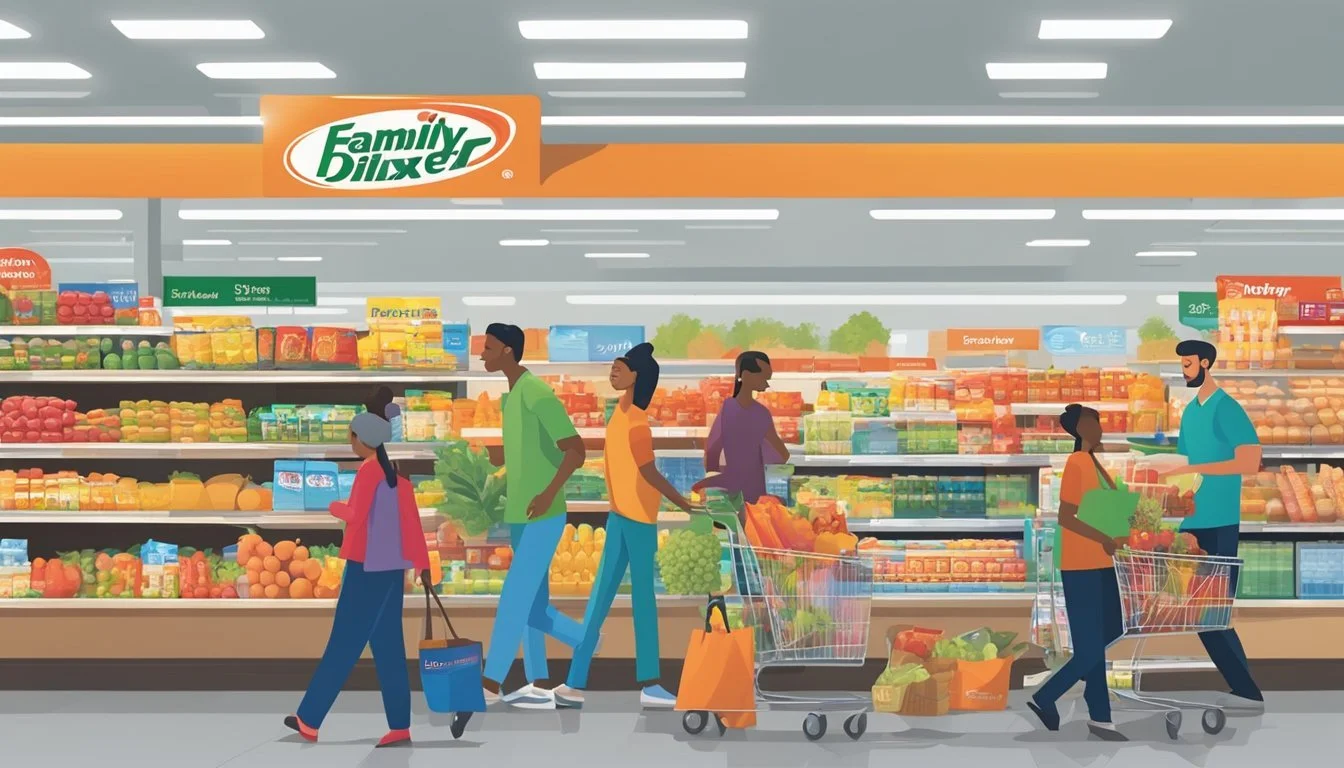Family Dollar vs Winn-Dixie
A Comprehensive Comparison of Prices and Selection
Grocery shopping can be a significant expense for families, making the choice of store crucial for budget-conscious consumers. Family Dollar and Winn-Dixie are two popular options in many areas, each with its own strengths and weaknesses.
When comparing Family Dollar to Winn-Dixie, Winn-Dixie generally offers a wider selection of fresh produce and groceries, while Family Dollar typically has lower prices on household items and non-perishables. This distinction can make a big difference depending on a family's specific needs and shopping habits.
The decision between these two stores often comes down to factors like product quality, store location, and overall shopping experience. While Family Dollar may appeal to those seeking quick, budget-friendly purchases, Winn-Dixie caters to shoppers looking for a more traditional grocery store layout with a broader range of food options.
Company Overview
Family Dollar and Winn-Dixie are prominent retailers in the American grocery landscape. Both companies have rich histories, significant market presence, and large customer bases, particularly in the southeastern United States.
History of Family Dollar and Winn-Dixie
Family Dollar was founded in 1959 by Leon Levine in Charlotte, North Carolina. The company started as a single store offering low-priced merchandise. It quickly expanded, becoming a successful discount store chain.
Winn-Dixie's roots trace back to 1925 when William Davis founded Winn & Lovett in Miami, Florida. The company grew through acquisitions, merging with Dixie Home Stores in 1955 to form Winn-Dixie Stores, Inc.
Both retailers faced challenges over the years. Family Dollar was acquired by Dollar Tree in 2015. Winn-Dixie filed for bankruptcy in 2005 but emerged in 2006. It later became part of Southeastern Grocers in 2012.
Market Presence and Store Locations
Family Dollar operates over 8,000 stores across 46 states. Its stronghold is in rural and urban areas, offering a mix of grocery and household items.
Winn-Dixie has a more focused presence in the Southeast. It runs approximately 500 stores in five states: Florida, Alabama, Louisiana, Georgia, and Mississippi. Florida houses the majority of Winn-Dixie locations.
Both chains target budget-conscious shoppers. Family Dollar's smaller format stores are often found in neighborhoods, while Winn-Dixie operates larger supermarkets in various communities.
Growth and Customer Base
Family Dollar has seen steady growth, expanding its store count and product offerings. It appeals to low to middle-income shoppers seeking everyday essentials at affordable prices.
Winn-Dixie has experienced fluctuations in growth. After its bankruptcy, it closed numerous stores but has since stabilized. The chain focuses on providing a full-service grocery experience with fresh produce, meat, and bakery departments.
Both retailers have loyal customer bases. Family Dollar attracts frequent, small-basket shoppers. Winn-Dixie caters to families doing weekly grocery shopping, offering a wider range of products and brands.
The companies continue to adapt to changing consumer preferences. Family Dollar is integrating more grocery items, while Winn-Dixie is enhancing its private label offerings and digital presence to compete with larger chains.
Product Offerings Comparison
Family Dollar and Winn-Dixie offer distinct product ranges to cater to different customer needs. Their selections vary in terms of variety, quality, and availability of specific categories.
Variety and Exclusive Brands
Family Dollar focuses on providing budget-friendly options with a limited selection of groceries and household items. They stock their own private label brands alongside select national brands.
Winn-Dixie, part of Southeastern Grocers, offers a broader range of products. Their shelves feature SE Grocers store brand items as well as an extensive array of national brands.
Family Dollar's product range is more compact, emphasizing essential items and quick-grab snacks. Winn-Dixie provides a full-service grocery experience with a wider variety of choices in each category.
Quality of Fresh Produce and Meats
Winn-Dixie excels in fresh produce and meat offerings. Their produce departments typically stock a diverse selection of fruits and vegetables, often sourced locally when possible.
The store's meat department features various cuts of beef, pork, and poultry. Winn-Dixie also offers seafood options in many locations.
Family Dollar's fresh produce and meat selections are limited. Some stores may carry basic fruits and vegetables, but the quality and variety are not comparable to Winn-Dixie.
Organic Options Availability
Winn-Dixie has expanded its organic offerings in recent years. Customers can find organic produce, dairy products, and packaged goods throughout the store.
The SE Grocers brand includes organic options, providing more affordable alternatives to national organic brands.
Family Dollar's organic selection is minimal. While they may stock some organic packaged goods, fresh organic produce is not typically available.
Dairy, Bakery, and Frozen Foods Selection
Winn-Dixie provides a full-service dairy department with a wide range of milk, cheese, yogurt, and other dairy products. Their in-store bakeries offer fresh bread, cakes, and pastries daily.
The frozen foods section at Winn-Dixie is extensive, featuring everything from frozen vegetables to complete meals and premium ice cream.
Family Dollar's dairy selection is basic, focusing on essential items like milk and eggs. They do not typically have in-store bakeries.
The frozen food options at Family Dollar are limited, primarily consisting of budget-friendly frozen meals and ice cream.
Pricing and Value
Family Dollar and Winn-Dixie employ different pricing strategies and offer varying value propositions for shoppers. Their approaches to everyday prices, discounts, and savings programs can significantly impact a family's grocery budget.
Everyday Prices and Discount Policies
Family Dollar focuses on providing low prices on a daily basis. Their smaller store format allows them to keep overhead costs down, which translates to lower prices for customers.
Winn-Dixie, on the other hand, tends to have slightly higher everyday prices but offers frequent sales and promotions. They run weekly specials on various items, particularly fresh produce and meats.
Both stores have competitive prices on staples like bread, rice, and sugar. Family Dollar often beats Winn-Dixie on packaged goods, while Winn-Dixie may offer better deals on fresh items.
Comparison with Competitor Pricing
When compared to other major retailers, Family Dollar and Winn-Dixie fall in the mid-range for pricing. Walmart typically offers lower prices than both, with a recent comparison showing Walmart's grocery total at $70.00 compared to Winn-Dixie's $99.46 for the same items.
Aldi and Costco often beat both stores on price for bulk purchases. Target and Kroger are generally more expensive than Family Dollar but may be comparable to Winn-Dixie depending on sales.
Publix tends to be pricier than both Family Dollar and Winn-Dixie, with one comparison showing Winn-Dixie 10% cheaper than Publix for a typical grocery haul.
Savings Programs and Coupons
Family Dollar offers a basic rewards program and accepts manufacturer coupons. They also provide digital coupons through their app, allowing customers to stack savings.
Winn-Dixie has a more robust rewards program called SE Grocers rewards. Members earn points on purchases and can redeem them for discounts on gas or groceries.
Both stores offer digital coupons, but Winn-Dixie typically has a wider selection. Winn-Dixie also runs "Buy One, Get One Free" promotions more frequently than Family Dollar.
Neither store doubles coupons, but both allow customers to combine manufacturer coupons with store coupons and sales for maximum savings.
Overall Value for a Family of Four
For a family of four, the better value between Family Dollar and Winn-Dixie depends on shopping habits and preferences.
Family Dollar may offer better value for:
Households that prefer packaged goods
Those who shop frequently for small quantities
Families looking for consistent low prices without tracking sales
Winn-Dixie might provide better value for:
Families who consume a lot of fresh produce and meats
Shoppers willing to plan around weekly sales
Those who can take advantage of fuel rewards programs
Price differences between the two stores can vary by 10-30% depending on the items purchased and current promotions.
Shopping Experience and Customer Service
Family Dollar and Winn-Dixie offer distinct shopping experiences tailored to different customer needs. Their store environments, layouts, and customer service approaches shape how shoppers interact with each brand.
Store Environment and Layout
Family Dollar stores typically feature compact layouts with narrow aisles packed with a variety of merchandise. The no-frills design emphasizes efficiency and value. Product categories are clearly marked, making it easy to find everyday essentials quickly.
Winn-Dixie, in contrast, presents a more traditional supermarket layout. Wide aisles, extensive produce sections, and full-service deli and bakery departments create a comprehensive grocery shopping experience. The stores often have a brighter, more open feel compared to Family Dollar.
Both chains prioritize cleanliness, though Winn-Dixie generally maintains a more polished appearance. Family Dollar's smaller footprint can sometimes lead to a cluttered impression during busy periods.
Customer Experience and Loyalty Programs
Family Dollar focuses on quick transactions and competitive pricing. Staff are trained to assist customers efficiently, but the emphasis is on self-service. The chain offers a basic rewards program through its app, providing digital coupons and personalized deals.
Winn-Dixie places a stronger emphasis on customer service, with more staff available to assist shoppers. Their loyalty program, SE Grocers rewards, is more comprehensive. It offers points on purchases, fuel discounts, and personalized offers.
Winn-Dixie stores often include additional services like pharmacies and coin-counting machines, enhancing the overall shopping experience. Family Dollar, while more limited in scope, excels in providing convenient access to everyday items at budget-friendly prices.
Operational Practices
Family Dollar and Winn-Dixie employ distinct operational strategies to manage their stores and serve customers. These practices influence their supply chains and ability to adapt to changing consumer preferences.
Supply Chain Efficiencies
Family Dollar focuses on a streamlined supply chain to keep costs low. The company operates distribution centers strategically located near its stores, reducing transportation expenses and ensuring quick restocking.
Winn-Dixie, as part of Southeastern Grocers, leverages its regional presence to optimize inventory management. The chain works closely with local suppliers to offer fresh produce and regional specialties.
Both retailers use data analytics to forecast demand and minimize waste. Family Dollar's smaller store format allows for faster inventory turnover, while Winn-Dixie's larger stores accommodate a wider product range.
Adaptation to Consumer Trends
Family Dollar has expanded its product offerings to include more household items and groceries. This shift addresses the growing demand for one-stop shopping experiences in budget-friendly stores.
Winn-Dixie has invested in improving product quality, particularly in fresh departments like produce and meat. The chain has also introduced more organic and health-focused options to cater to health-conscious consumers.
Both retailers have embraced digital technologies. Family Dollar offers mobile coupons and a rewards program, enhancing value for money. Winn-Dixie has implemented online ordering and curbside pickup services to meet evolving shopping preferences.
Family Dollar's smaller stores allow for quicker adaptations to local trends. Winn-Dixie's larger format provides space for in-store experiences like cooking demonstrations and product sampling.





